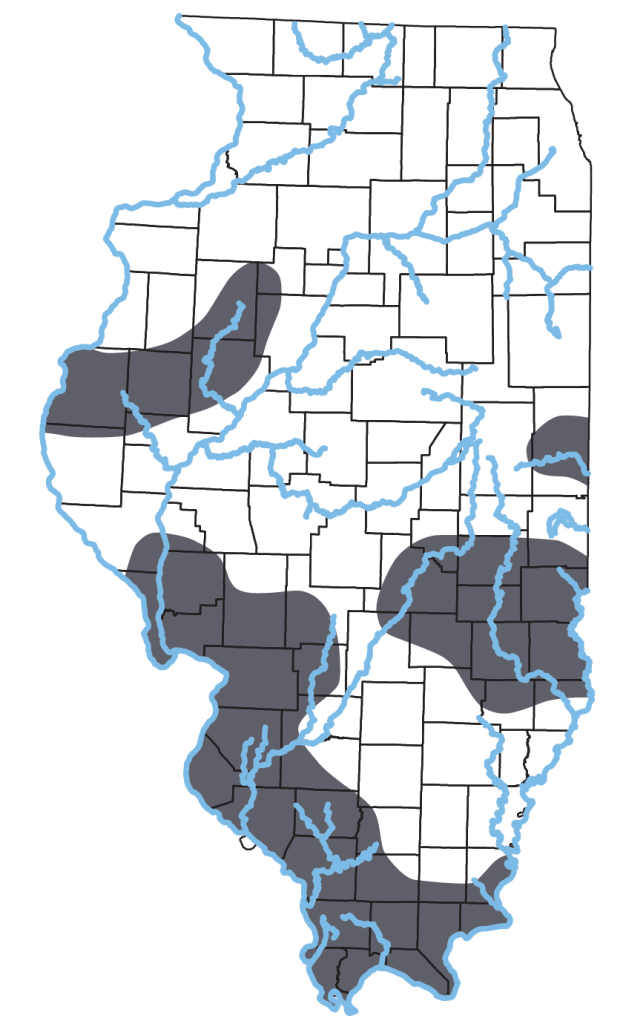Virginia valeriae (Baird & Girard, 1853)

Key Characters: Back scales weakly keeled and in 17 rows; anal plate divided.
Similar Species: Ring-necked Snake, Dekay’s Brownsnake, Red-bellied Snake, Midwestern Wormsnake. See the Key to Snakes of Illinois for help with identification.
Subspecies: Three subspecies are recognized; Western Smooth Earthsnake – V. v. elegans Kennicott (1859, Proc. Acad. Nat. Sci. Philadelphia 11:98-100); Mountain Earthsnake – V. v. pulchra Richmond (1954, Ann. Carnegie Mus. 33:251-260); and Eastern Smooth Earthsnake – V. v. valeriae Baird and Girard (1853). Only the Western Smooth Earthsnake, V. v. elegans is found in Illinois.
Description (modified from Smith, 1961): Small (up to 35 cm TL) snake with 17 rows of faintly keeled scales; ventrals 118 to 132; caudals 31 to 46; anal plate divided; supralabials 6 + 6; infralabials 5 to 7 on a side; tail length less than 22 percent of total length; head thick; nose rather sharply pointed; dorsum olive, medium brown or gray-brown, sometimes with minute dark flecks; venter white, usually with a slight greenish yellow tint and sometimes with a few dark flecks on sides of ventrals.
Habitat: Rocky, wooded hillsides.
Natural History: Semifossorial and nocturnal. Surface activity sometimes stimulated by heavy rains. Often found in or under rotting logs, as well as under rocks and in forest-floor leaf litter. Mates late April or May, after emerging from hibernation in deep hillside crevices, and 3-8 tiny young are born in August. Newborn 7–12 cm TL and may be darker than adults. Diet includes mainly earthworms and other soft-bodied insects, slugs, and snails. Predators include other snakes, birds, and mammals.
Status: Locally common in the Shawnee Hills and the bluffs along the Mississippi River in southern counties.
Etymology: Virginia – virgo (Latin) meaning virgin. This name might have been coined for the state of Virginia; valeriae – (New Latin) in honor of Valery Blaney (1828-1900), collector of the type specimen; elegans – (Latin) meaning tasteful, choice, fine, select.
Original Description: Baird S.F. & C. Girard. 1853. Catalogue of North American Reptiles in the Museum of the Smithsonian Institution. Part I. Serpents. Smithsonian Institution. 172 pp.
Type Specimen: Holotype, USNM 1962, collected by Valeria Blaney
Type Locality: “Kent County, Maryland”
Original Name: Virginia valeriae
Nomenclatural History for the subspecies V. v. elegans: Kennicott (1859, Proc. Acad. Nat. Sci. Philadelphia 11:98-100) described V. elegans based on a specimen collected in the “heavily timbered regions of southern Illinois”. Holotype not designated, but Pisani (1972, Herpetologica 28:348) made a valid argument for Chicago Academy of Sciences (CA) 126 to be the holotype. That would restrict the type locality to Union Co., IL. Blanchard (1926, Pap. Michigan Acad. Arts Sci. Lett. 3:343-365) placed it as a subspecies of V. valeriae. Other names that have been used in the Illinois literature include Haldea valeriae elegans (Stejneger & Barbour, 1939, A Checklist…4th ed.); V. harpeti elegans (Boucourt, 1886) and Potamophis striatulus (Van Cleave, 1928, Illinois State Acad. Sci. Trans. 20:133-136).


